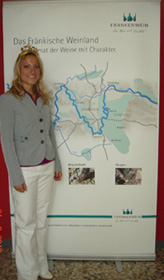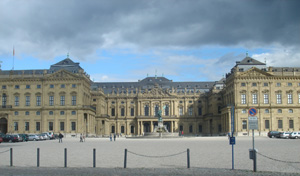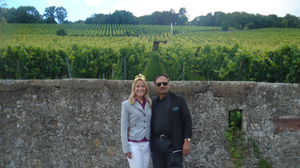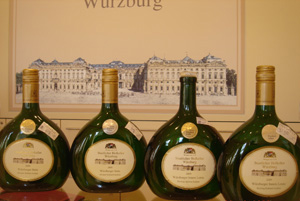 |
| Map of Franconia Winelands with the Wine Queen Melanie Unsleber |
Many historical celebrities have visited and sung praises about wines from Franconia, including Martin Luther and the well known German poet Johann Wolfgang von Goethe who coined the quote ‘Life is too short to drink bad wine.’ He is on record to have also written to his wife, ‘Send me more of that Würzburger for no other wine can please my palate.’ Heart of Franken Winelands
Würzburg is the unofficial capital of Franconia (Franken) and the heart of its Winelands. A major junction and entry point for wine tourists (120 kms from Frankfurt), it also has trains from north to south of Germany as well as from east to west passing through. As with most wine regions in Germany, the quality grape growing is aided by its vicinity to River-Main (pronounced as ‘mine’) which meanders along through the city.
 |
| Würzburg Residence- venue for Staatlicher Hoftkeller winery |
The world-famous Würzburg Residence, a UNESCO World Cultural Heritage property, built by Prince-Bishop Schönborn 230 years ago is not only worth visiting for its beauty but has an old winery, Staatlicher Hoftkeller still being run by the State of Bavaria. It is difficult to imagine an old, working winery as beautiful as this, anywhere else in Germany and it alone merits a side visit from Frankfurt airport for a day trip. Incidentally, another well-known wine estate Weingut Graf van Schönborn is run by a descendent of the late Bishop. If Bordeaux is known to have had 1945 as the vintage of the millennium, this city would remember the year as its darkest in the twentieth century, with the bombing in March 1945 by the Allied forces which practically destroyed 90% of the city and took almost 50 years to rebuild, still leaving many scars behind, making one wish to ‘make wine, not war!’
Land of Silvaner
It is in Franconia that Silvaner grape was first grown in Germany 351 years ago by Castell. Despite other regions of Germany and countries like Italy (Alto Adige) and France (Alsace) growing this white varietal, it remains the most characteristic and leading variety of this region. Prof. Dr. Gian Luca Mazzella, a well known Italian journalist from Rome and a Silvaner specialist, who conducted the 350-year celebratory historical tasting last year of 26 legendary Silvaners from 1915-1951 in Schloss Castell, says ‘Franconian land is truly a Silvaner land’.
 |
| View of Würzburger Stein vineyards from Würzburg Am Stein winery |
‘It maintains its leading position and has become synonymous with the region, just as Pinot Noir is synonymous with Burgundy, ‘says Karl Martin Schmitt, head of the VDP branch in Franken. The reason for the popularity is simple- Silvaner wines are agreeable, versatile, truly reflect their terroir and are very easy to pair with a wide variety of food.
It is a tribute to the ageing potential of the Silvaner that the 1915 Schloss Hallburger Sylvaner (as it was spelt those days) from Weingut Graf van Schönborn and the 1959 Bürgerspital Silvaner Trockenbeerenauslese (TBA) from the steep Würzburger Stein vineyards on the banks of River Main, owned by Weingut Bürgerspital, (coincidentally, both of which I was fortunate to visit last week) were both alive and kicking.
Much improved quality
However, the Franconian wines have also gone through an identity crisis in the recent decades. As with many wines in Germany, their quality also went down drastically and many producers found themselves suddenly cornered a decade ago- not unlike the recent situation in Nashik and other wine producing centers of Maharashtra. Customers were not willing to buy the cheap wine. That’s when the producers realised and decided that improving quality was the only solution.
The unsold wine was distilled, investments were made in improved viticulture with yields reduced, winemaking was also improved with new equipment in place with the financial help of the government and EU and since then there have been continuous efforts to improve the quality. Today, Franconia is considered one of the respected and cherished wine regions and although at 6000 hA of production it is very small with respect to the other regions, it maintains its importance in Germany as well as the international markets.
Bocksbeutal – the bottle with tradition
 |
| Bocksbeutal, the traditional Franconian wine bottle |
Franconia wines can be distinguished through the typical Franconian bottle which has a trademarked green coloured, fat-bellied, rounded shape and is known as Bocksbeutal. Bordeaux and Burgundy bottles are also used commonly by every winery. Interestingly, the basic, low or entry level wines are bottled in a Bordeaux bottles while the very exclusive, single vineyard or special wines are generally sold in Burgundy bottles. Though there is no law but this is the general tradition. Wine in the traditional Bocksbeutal bottle is generally of good quality from the producer and is generally classified as tradition wine. Grapes of Franconia
Although Silvaner remains the leading and signature grape of the region, two other varieties are also quite popular-Riesling and Müller Thurgau which though still leading in acreage is becoming gradually less popular. As any producer will tell you, growing of Silvaner and Riesling depends a lot on the soil, terroir and micro climate. Although most would like to indulge in their passion and craft wines only from Silvaner, not every soil is suitable for it. Same goes with Riesling which has its own special character from this region. Müller Thurgau is an easier making and easier drinking young fruity and pleasant wine and apparently caused a lot of damage to the region in the last century because of making too much of cheap wine.
Pinot Blanc (Weisserburgunder) is another passion with a majority of growers. The other white varieties grown are Kerner, Bacchus (slightly sweet, full bodied and fruity) and Scheurebe (late ripening, high acidity and full bouquet) and Blue Silvaner and Grauburgunder (Pinot Gris/Grigio)
Franconians are quite enamoured with Pinot Noir and are racing along in order to improve the quality. Domina, Dornfelder and Portugieser are minor varieties grown, some use them as varietals, and mostly find them quite useful in the blends. There are a few other varietals like Rieslaner which are grown in insignificant quantities and usually as blends.
Grape Growing Regions
Although in the political map Franconia is divided into Upper, Middle and Lower Franconia- the grapes are grown in three regions located mainly in the last two. In the Middle Franconia, near the town of Volkach where River Main makes a V-shape and consequently a triangle called ‘Main Triangle’ (maindreieck) - about 4000 hAs are grown. The balance is divided between the foothills of Steigerwald forests in the East and a ‘Main rectangle’ (mainviereck) in the West. (Incidentally, I had trouble pronouncing the words for these two Districts until I realised it was main-drei-eck and main-vier-eck! I didn’t need my knowledge of trigonometry to pronounce it now).
The soil varies extensively within the different regions giving a definite and different character to even the same grape variety.
Falling in Love with German Tuscany
But wherever you go, you find the vineyards on the rolling hills-reminding you of Tuscany. No wonder the region is often referred to as the Tuscany of Germany. A cluster of wineries in the southern part of Steigerwald find the area so beautiful and charming that they have classified it as ‘Wine Paradise’ and promote it as such-for wine tourism.
Next time you want to fall in love again-with the beauty of nature and wine, try a diversion from Frankfurt airport for a couple of days in Würzburg where you can visit several historical buildings, churches and castles, several wineries, taste some excellent wines. If you have time and want to take a longer vacation into the wine paradise of Germany and feel the clock slowing down.
For more details visit www.frankentourismus.de or write to info@frankentourismus.de. You may also write to the Association of Franconian wines at:
info@frankenwein-aktuell.de or visit http://www.franken-weinland.de/
Subhash Arora
Wineries visited to be covered in the next issue:
Weingut Graf von Schönborn
Gutsverwaltung Schloss Frankenberg
Staatlicher Hoftkeller Würzburg
Weingut Bürgerspital Würzburg
Weingut Am Stein Ludwig Knoll, Würzburg |